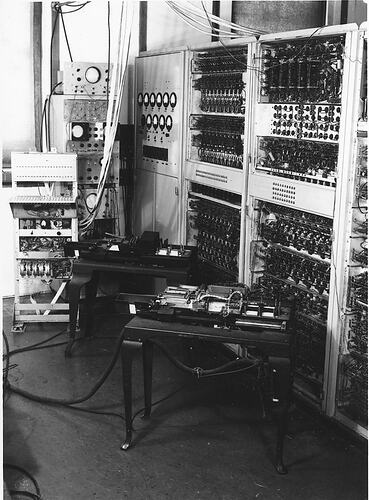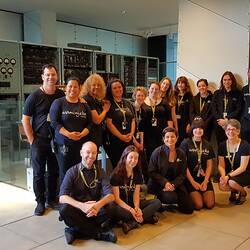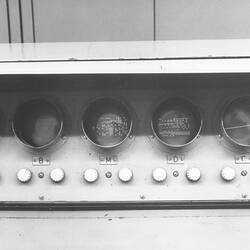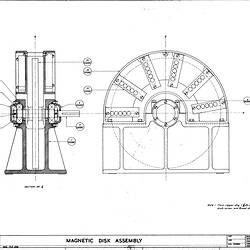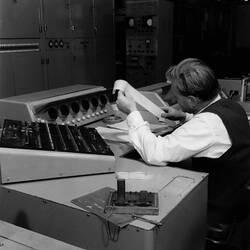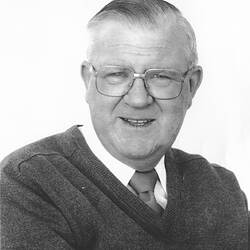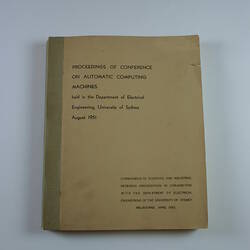CSIRAC, designed and built by CSIR scientists, was the first stored-memory electronic computer in Australia.
In 1947 Maston Beard and Trevor Pearcey (a British radar scientist who had emigrated to Australia after World War II) led a research group at the CSIR (after 1949 called CSIRO) Radiophysics Laboratory which designed and built CSIR Mk1, the world's fourth stored-memory electronic computer. The first program was run in 1949 and the machine was in full operation by 1951. It embodied many features novel at the time and was able to operate more than 1000 times faster than the best mechanical calculators.
In 1955 the computer was transferred to the University of Melbourne where renamed CSIRAC it continued to operate until November 1964.
Background
In the period immediately following World War II it was perceived that the scientific and industrial communities would require greatly increasing quantities of computing work in the future.
In 1948 Australia's Council for Scientific and Industrial Research (CSIR) established a Section of Mathematical Instruments at the National Standards Laboratory in the grounds of the University of Sydney. The section was established to research and develop mathematical methods, devices and instruments and to provide mathematical and computational assistance for researchers. At the same time a group within the Radiophysics Division of the CSIR, housed at the same location at the University of Sydney, was working to develop an electronic means of digital computation. The Chief of Radiophysics, EG Bowen, had been involved in the British work on radar and his deputy, J.C. Pawsey had worked on high definition television with EMI in Britain.
It was at the Division of Radiophysics that the CSIR Mark 1 computer was designed by Trevor Pearcey and Maston Beard. From 1940 to 1945, Pearcey had worked on the mathematical aspects of the development of short wave and microwave radar in Britain. This work required large scale computation and the use of analogue and digital aids. Maston Beard had worked in the Radiophysics Division at the University of Sydney and was experienced in practical vacuum tube-based pulse techniques. The Mark 1 came as a logical follow-on to experimental studies in design of electronic logic components.
Although ideas for the development of the Mark 1 computer were separate from the mainstream developments occurring at that time in Britain and the United States, it was the fourth stored memory or stored program computer in the world. The design was completed in 1947, construction of the computer was commenced in 1948 and the first program was run in 1949. The completed computer was referred to as the CSIR Mk1.
The Machine
The CSIR Mk1 was structured for engineering simplicity and flexibility. The objective was the development of programming techniques leading later to breadth of application. The machine was entirely serial in operation and contained 2000 valves or vacuum tubes. It had a speed of 500 instructions per second, which was raised by stages to 1000 operations per second, using a mercury acoustic delay store of 20 bits each up to 1024 words. Extensions included additional magnetic drum storage. Input and output, initially via punched cards, was changed to 12 hole and later standard 5 hole paper tape was introduced for programs run under Interprogram.. The Sydney 12 hole readers and punches had mechanical tractor sprockets, whereas in Melbourne, the movement was electromechanical. The machine consumed about 30 kw of power, the heat from which was removed by blowing cool air through the cabinets. The delay store and arithmetic/logic registers were thermally controlled at above the highest summer room temperature to keep the acoustic velocity of the mercury medium constant.
CSIR Mk1 was utilised by scientists within the CSIRO (as it was named from 1949) and later did calculations for the Snowy Mountains Hydro Electric Authority. It was used for programming studies, computations for radioastronomy and cloud physics for Radiophysics researchers and computations for CSIRO Divisions, engineering projects, various university and government departments and agencies.
From Sydney to Melbourne
As demand for computer work grew in quantity and complexity it was perceived that a more powerful and faster machine would be needed. Early in 1954 it was decided to build a version of the ILLIAC (University of Illinois Automatic Computer) at the University of Sydney.
In 1956 it was proposed to send CSIRAC to Melbourne, initially to the Aeronautical Research Laboratories; later the University of Melbourne was settled upon. The computer was dismantled and trucked to Melbourne, to the University of Melbourne Computation Laboratory under Thomas Cherry (Department of Applied Mathematics), with its operations managed by Dr Frank Hirst. The CSIRO contributed to the cost of the transfer of the computer and to the establishment of the computer laboratory. The laboratory was formally opened by the Chairman of the CSIRO, Sir Ian Clunies-Ross, on 14 June 1956.
The computer, renamed CSIRAC, performed work for the CSIRO, government departments and private corporations as well as for the University of Melbourne until being decommissioned on 24 November 1964.
Life After Decommissioning
In March 1965, Dr Frank Hirst, of the University of Melbourne, arranged for CSIRAC to be donated to the Institute of Applied Science of Victoria (a predecessor of Museums Victoria), on behalf of the CSIRO. It was initially stored by the Museum at its Abbotsford warehouse until being place on long-term loan to the Caulfield Institute of Technology (later Chisholm Institute of Technology and now Monash University, Caulfield Campus), where is was on public display from 1980 until 1992.
In 1996, CSIRAC was loaned to the Department of Computer Science at the University of Melbourne where it was reassembled and used as the centrepiece for a conference celebrating the 40th anniversary of its recommissioning in Melbourne in June 1956, which brought together computing pioneers who had worked with CSIRAC. The machine was again temporarily displayed by the Museum at its Moreland store in November 1999, at a celebration to mark its 50th anniversary.
Following several years of dedicated work by Museum staff and volunteers from the CSIRAC history team at the University of Melbourne, CSIRAC was placed back on public display, forming the centrepiece of the @digital.au exhibition in the Science & Life Gallery when the new Melbourne Museum opened at Carlton Gardens in October 2000. The display presented the computer as it appeared when set up at the University of Melbourne Computation Laboratory in 1956.
Victorian Heritage Register 2009
CSIRAC received a fitting 60th birthday present in October 2009 when it was listed on the Victorian Heritage Register. The register citation lists CSIRAC's hardware and software, including cabinets, consoles, power supplies, circuits and over 400 programs stored on paper tape. Objects and places on the register have significance to the history and communities of Victoria, and are afforded the highest level of heritage protection. Previously, CSIRAC was awarded a National Engineering Heritage Landmark plaque by Engineers Australia in 2004.
In November 2010, CSIRAC was transferred to a smaller display on the west side of the Lower Ground Floor Entrance Lobby at Melbourne Museum. In November 2017, CSIRAC was transferred to Scienceworks in Spotswood, where it was initially held in temporary storage, before being placed on public display once again in June 2018.
Further Reading
Beard, M & Pearcey, T. 1984. The Genesis of an Early Stored-Program Computer: CSIRAC. Annals of the History of Computing 6(2) 106.
McCann, D. & Thorne, P. 2000. The Last of the First: CSIRAC: Australia's First Computer. Department of Computer Software Engineering, The University of Melbourne.
More Information
-
Keywords
-
Authors
-
Article types
